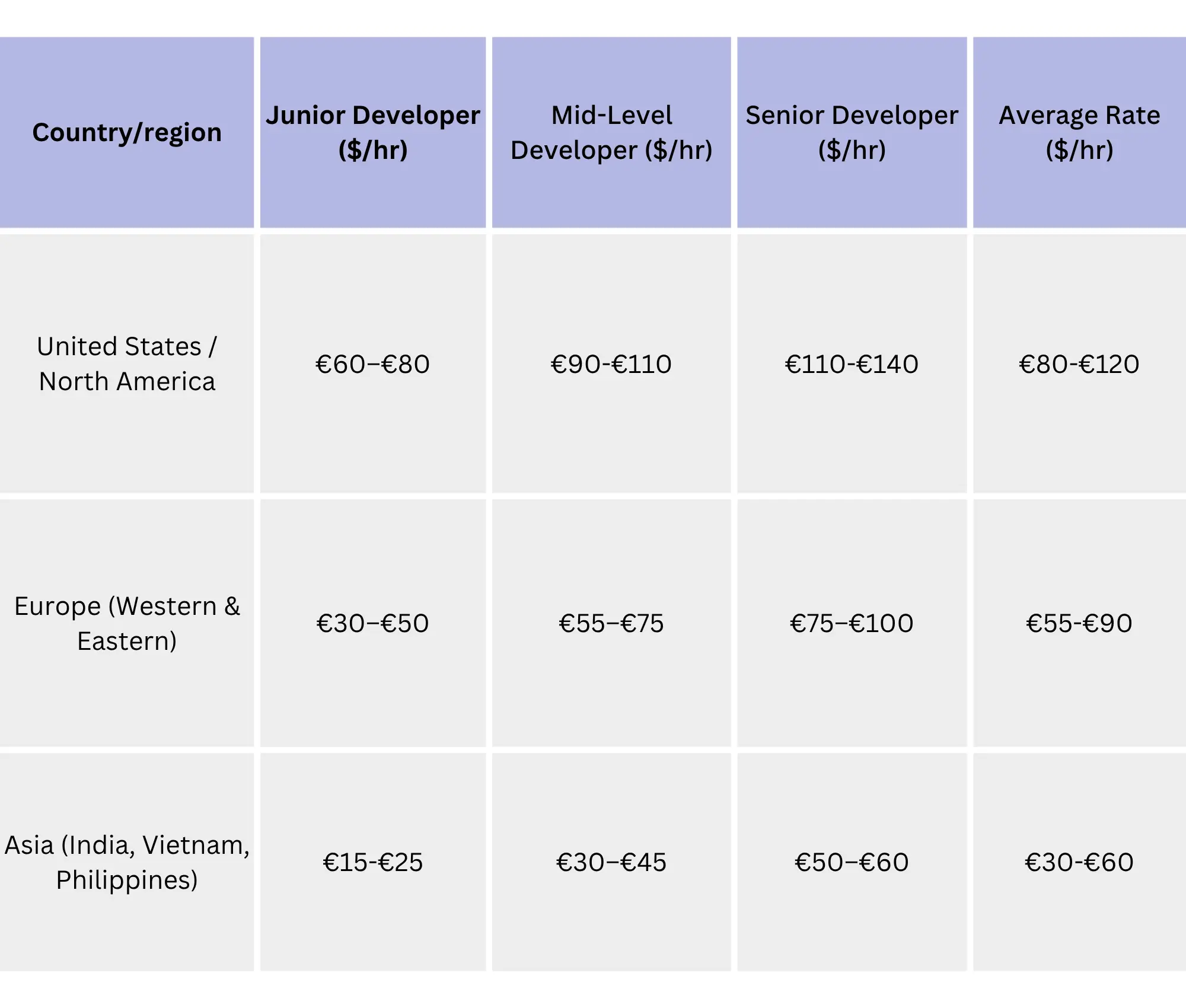Nearshore software development rates: What you need to know
Nearshoring, or in other words, outsourcing software projects to nearby countries with similar time zones and cultural alignment, is gaining momentum among companies seeking to minimize offshoring challenges while keeping costs under control.
In this article, we break down nearshore software development rates, highlight key benefits, showcase regional examples, and offer strategic insights to help businesses across the USA, Europe, and Asia navigate this model effectively in 2026.
What is nearshore software development?
Nearshore software development is a model of outsourcing where companies collaborate with software teams located in nearby or neighboring countries. Unlike offshore outsourcing, where the service provider might be on the other side of the globe, nearshore partnerships offer a closer geographical, cultural, and time zone alignment that makes day-to-day collaboration smoother and more effective.
For example, U.S. companies often partner with teams across Canada or Latin America, while European firms collaborate with developers in Eastern and Central Europe - from Poland and Bulgaria to Romania. In Asia, nearshore development typically occurs between regional hubs such as Singapore, Malaysia, and Vietnam, where cross-border collaboration is seamless and cost-efficient. This model strikes the perfect balance between cost savings, communication, and quality. You still benefit from lower labor costs compared to onshore development, but without the challenges that often come with managing offshore teams in distant time zones. The result is faster turnaround times, easier collaboration, and stronger relationships built on shared business culture and language proximity.
Nearshoring has become especially popular among startups and mid-sized tech companies that want to scale efficiently without sacrificing control or team synergy. Whether it’s building a new product, extending an existing development team, or modernizing legacy systems, nearshore development gives companies the flexibility to access top-tier talent - just a short flight or call away.
Understanding nearshore rates
Nearshore rates generally fall between onshore and offshore costs, influenced by factors like market maturity, supply-demand balance, expertise, and local economies. For instance, average developer rates in Europe range between $55 and $90 per hour, which is lower than the U.S. average of $80–$120, but higher than Asia’s range of $30–$60 per hour. These rates reflect advantages like stronger language skills, better legal certainty, and easier travel for on-site visits when needed.
Several factors influence nearshore rates:
- Country and market maturity: More established markets will have higher rates.
- Skill level: Senior developers and specialists cost more.
- Project scope and complexity: More complex projects need more investment.
- Engagement model: Whether it’s staff augmentation, dedicated teams, or project-based contracts.

Nearshore pricing offers a good balance of cost, quality, and convenience, making it attractive to companies that want agility without sacrificing control. Rates in key European hubs like Bulgaria reflect strong technical education, English proficiency, and EU compliance that justify slightly higher costs than offshore alternatives in Asia.
Key benefits of nearshore outsourcing
- Time zone overlap: Nearshore teams operate within similar hours, enabling real-time collaboration and faster feedback cycles. For instance, U.S. companies working with partners in Canada or Latin America can easily align their daily schedules, while European firms nearshoring to Eastern Europe enjoy the same overlap.
- Cultural affinity: Shared communication styles and business ethics make it easier to collaborate effectively. European and North American teams working with regional partners often experience fewer misunderstandings compared to offshore setups.
- Legal security: For EU-based companies, nearshoring within Europe ensures GDPR compliance and simplified data protection. Similarly, U.S. partnerships within nearby regions benefit from stronger contractual enforcement than many offshore destinations.
- Faster travel: Shorter distances allow convenient on-site meetings when needed, whether it’s a two-hour flight from Germany to Poland or a quick trip from San Francisco to Vancouver.
- Quality at competitive cost: Nearshore development combines cost efficiency with skilled expertise. European rates average $55–$90/hour, offering a middle ground between U.S. rates ($80–$120/hour) and Asian rates ($30–$60/hour), providing strong value without compromising quality.
Challenges and considerations
- Rising talent demand: As nearshore destinations mature, especially in Eastern Europe and parts of Asia, developer rates are climbing due to increased competition for skilled engineers.
- Smaller talent pools: Compared to vast offshore markets like India or China, some European nearshore markets (e.g., Poland, Czech Republic) have more limited workforce availability, affecting scalability.
- Management required: Even with better time zone alignment, nearshore projects still require governance, consistent communication, and clear project ownership to ensure smooth delivery.
Real-world nearshoring scenarios
- SaaS scale-up (USA → Canada): A U.S.-based SaaS company partners with a development team in Mexico to expand its product features. With developers charging around $45 per hour, the company achieves significant cost savings while maintaining agility through daily standups, real-time collaboration, and quick iteration cycles. The shared time zone ensures smooth coordination between product managers and engineers.
- Enterprise systems (Germany → Poland): A German financial enterprise chooses to nearshore to Poland, hiring developers at about $60 per hour to build complex compliance and reporting systems. Beyond technical skills, the team benefits from the EU’s shared legal and data protection frameworks, ensuring secure collaboration and trustworthy delivery for sensitive financial operations.
- Fintech platform (Singapore → Malaysia): A Singaporean fintech startup nearshores development to Malaysia, where rates range between $35–$55/hour. The team’s regional familiarity with financial standards and API security enables faster deployment and smooth communication. The short flight and shared business culture make it an ideal regional collaboration model.
Best practices for managing nearshore rates in 2026
- Partner vetting: Select partners with proven expertise in your industry and compatible communication culture. For instance, many U.S. firms prefer Canadian vendors for English fluency and shared work standards, while European companies partner with established Central or Eastern European providers for technical excellence.
- Clear contracts: Clearly define service levels, deliverables, IP ownership, and payment terms. European and U.S. companies should ensure agreements comply with regional data laws such as GDPR or CCPA.
- Utilize tools: Use tools like Microsoft Teams, Zoom, Jira, Asana, or Confluence to streamline communication and project tracking across borders. Consistent use of these tools minimizes confusion in multi-regional setups.
- Establish governance: Implement a structured governance model with measurable KPIs, progress reviews, and transparent reporting. Regular performance check-ins ensure that nearshore partners remain aligned on deliverables and quality expectations.
- Flexible models: Consider hybrid models, combining nearshore development teams in Europe or Asia with onshore management in the U.S. or Western Europe. This approach helps balance cost, control, and communication.
Why are nearshore rates rising?
Across the USA, Europe, and Asia, nearshore hubs are evolving from simple delivery centers into innovation-driven ecosystems. Cities like Warsaw, Kuala Lumpur, and Toronto are now home to advanced R&D, AI, and cloud engineering talent. This shift has created strong demand, driving hourly rates upward as competition for qualified developers intensifies. Additionally, vendors are investing more in modern infrastructure, cybersecurity, and AI-powered development pipelines. These enhancements improve productivity but also increase operational costs. Rising expectations for compliance, governance, and data protection, especially under GDPR and ISO 27001 standards, further contribute to rate growth. Ultimately, higher nearshore rates reflect a maturing global outsourcing market - one where clients pay for greater value, reliability, and innovation rather than just cost savings.
Conclusion
Nearshore software development in 2026 strikes a balance of affordability, quality, and proximity unmatched by offshoring alone. Companies gain faster feedback, reliable workflows, and regional compliance benefits while managing costs effectively. As organizations face talent shortages and regulatory complexity in 2025, nearshore partnerships deliver a practical, strategic solution. For exploring nearshore vendors, reference platforms like Clutch, Glassdoor, and Upwork for ratings and reviews.


Why Codelevate is your best outsourcing partner
At Codelevate, we’re all about working closely with our clients to create high-quality, scalable solutions that match your business goals and timelines. We keep things simple with a fixed pricing model, so there are no surprise costs or scope creep along the way. With over 120 clients under our belt, we’ve got the experience to manage projects of all sizes. We’re also committed to data privacy and sustainable practices, so you can trust that your project is in good hands. Whether you're a startup or an established enterprise, our team’s expertise in SaaS and AI is always here to help you succeed.





.webp)
.svg)




